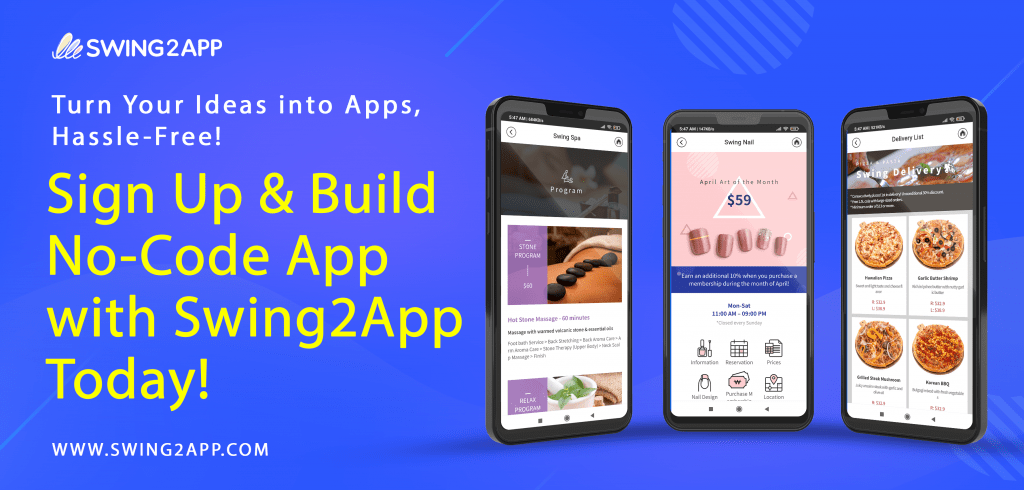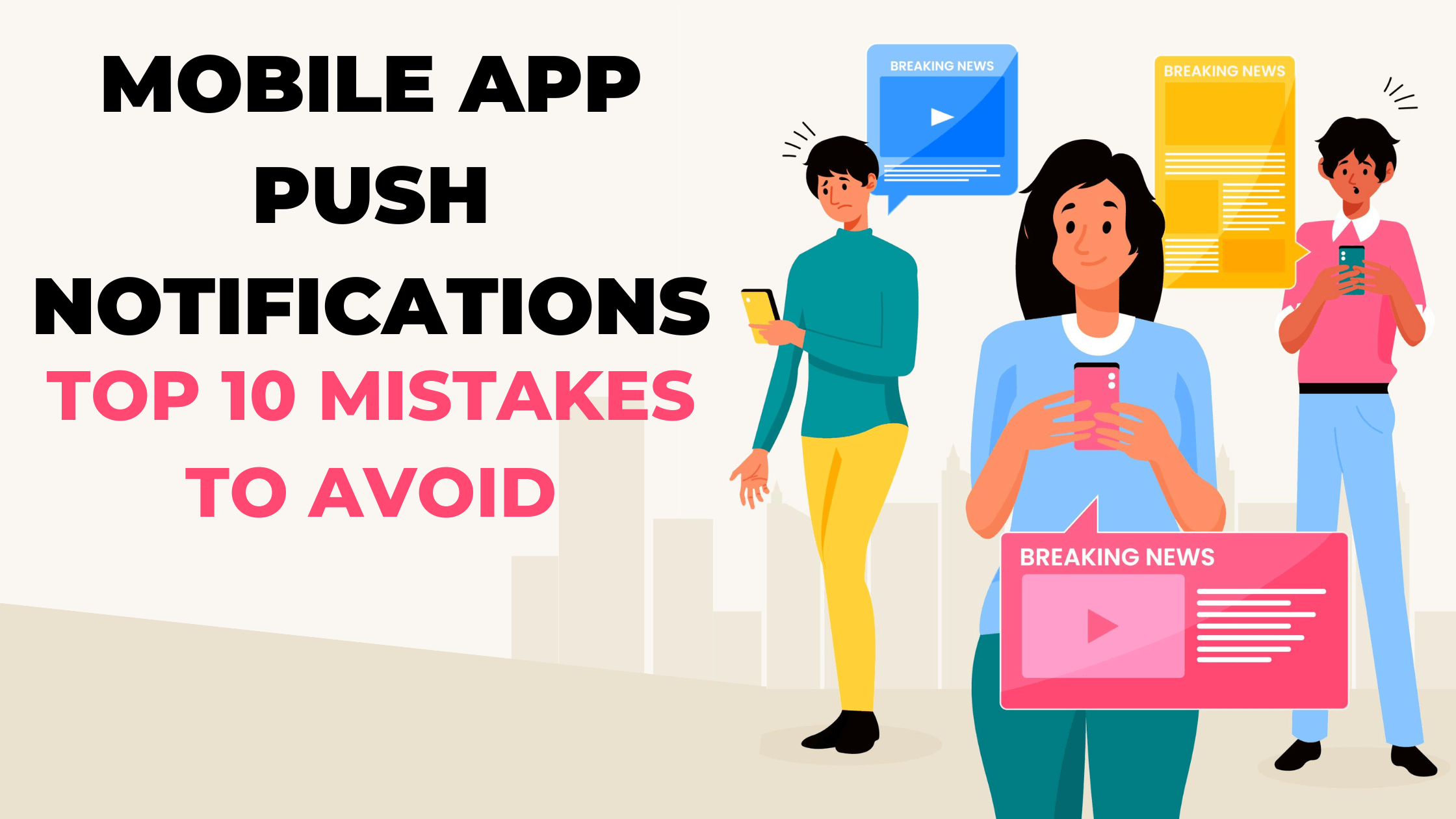Struggling with your push notifications? Discover 10 common push notifications mistakes and how to steer clear of them for a better experience.
Have you ever been rudely awakened by the relentless beeping of your phone, only to find it’s just another promotional message or an app notification? These nuisances can lead to app uninstalls and subscription cancellations. Picture this: you’re enjoying an afternoon coffee break, checking your phone for missed calls, texts, or emails when a push notification pops up. It’s about a sale on those boots you’ve been eyeing, complete with pictures and a special promo code. You immediately open the app, find your favorite pair, and make the purchase. That’s the power of a well-timed push notification.
However, push notifications can either engage or annoy users. To ensure they’re effective, you need to steer clear of these ten common push notifications mistakes. But, first, let’s understand a bit about push notifications and their importance.
WHAT ARE PUSH NOTIFICATIONS?
Push notifications are the short CTA (Call-to-action) message that pops up on your phone, even when you’re not using that app. Apps generally send push notifications to get your attention and share important information, reminders, or exciting offers with you.
These notifications usually have a title, a message, a picture, and a web link. Sometimes, they can also have logos, images, or emojis to make them look more attractive and fun. Depending on whether you use an Android device or an Apple phone, push notifications might look a bit different.


So, the next time you see a such message pop up on your device’s screen, it’s probably a push notification trying to tell you something interesting!
WHY ARE PUSH NOTIFICATIONS IMPORTANT?
Push notifications are like secret messengers for your mobile apps. They pop up on your device to grab your attention, even if you’re not using the app. Here are five cool reasons why they matter:
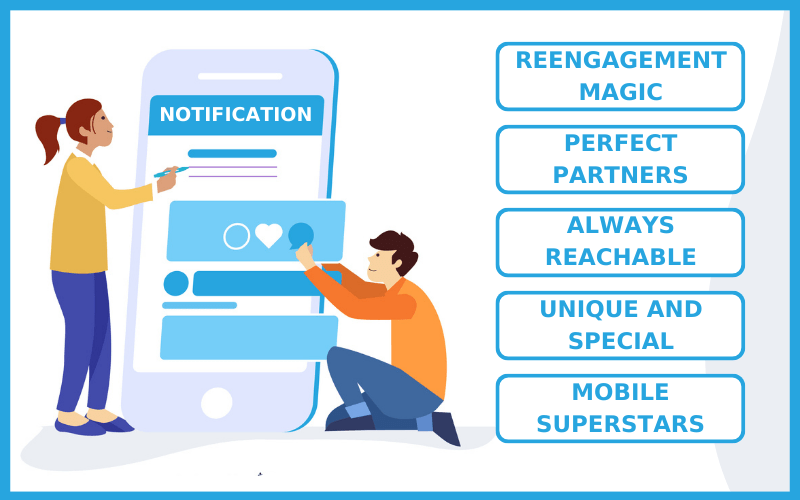
Always Reachable: Push notifications can talk to app users anytime, anywhere, whether they’re using the app or not. That’s like having a direct line to your users’ attention.
Reengagement Magic: If people forget about your app, push notifications can remind them it exists and bring them back. It’s like a friendly nudge, saying, “Hey, we’re here!”
Perfect Partners: They work great alongside emails, text messages, and web notifications. It’s like having a superhero team of communication.
Mobile Superstars: When we say, “push notifications,” we often mean the ones on mobile devices. They’re super popular and have superpowers to capture attention.
Unique and Special: Push notifications have a unique charm. They always stand out in a crowd of boring SMSs and other alerts, making sure you don’t miss the important stuff.
So, remember, push notifications are your app’s little helpers, ensuring your messages reach the right people at the right time.
For more information read: Push Notification Explained And Why Do They Matter?
Also read: Push Vs SMS: Which Is Better?
TOP 10 MISTAKES TO AVOID WHILE SENDING PUSH NOTIFICATIONS
Following are the top 10 common mistakes that you must avoid while sending mobile app push notifications.
1. USING PUSH NOTIFICATION AS EMAIL REPLACEMENT:
Push notifications are like digital post-it notes for your users. They can be used for different purposes, just like emails. You can send out announcements, order updates, and special offers through channels like SMS, in-app messages, and emails.
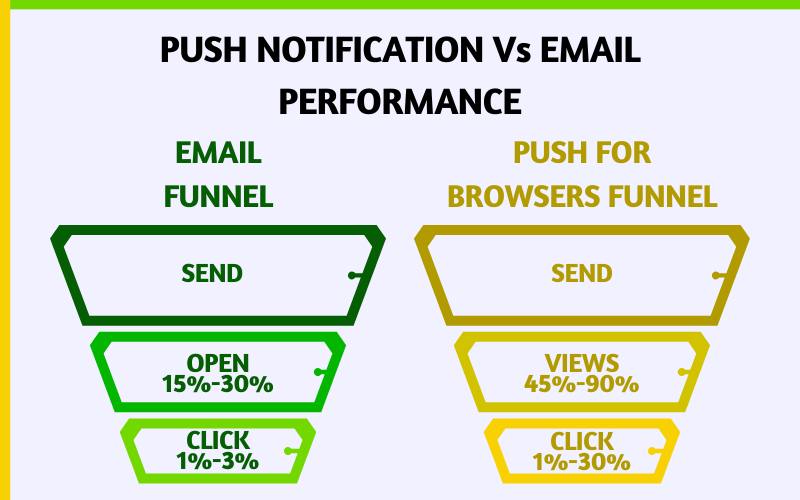
Sending push notifications, the correct way:
Push notifications work best when they’re like a friendly tap on the shoulder, sharing info that’s super relevant right now. Think about things like nearby deals, price drops, or limited-time offers. Save those push notifications for moments when your users will really appreciate them.
Bad Push Notification:
“Get 10% off at our store today! Hurry, the offer ends soon!”
Better Push Notification:
“Hey there! 🛍️ Looking for deals nearby? Check out our store for a surprise 10% discount today, just for you! But don’t rush, you’ve got all day to enjoy it. 😉”
2. NOT TARGETING THE PUSH NOTIFICATIONS:
When a user downloads your app, it clearly indicates their interest in your brand. It’s your golden opportunity to understand their preferences better. Start by collecting data on how they interact within the app and use this valuable information to craft user engagements that lead to higher conversions.
Sending push notifications, the correct way:
Instead of sending generic messages at your convenience, consider messages triggered by user actions or inactions. Align your marketing communication with the user’s journey toward making a purchase. Some key moments in the user’s app journey that have proven to boost engagement in e-commerce apps include:
First App Opening: Provide a warm welcome and guide users to relevant products and categories. Suggest items based on what’s frequently bought or similar to their preferences.
New User: Make new users feel special and engaged.
Cart Abandonment: Send a friendly reminder about the items left in their cart, encouraging them to complete their purchase.
Price Drop Alerts: Notify users about price drops on products they’ve recently viewed, added to their cart, or wish list.
Re-Engagement: For users who’ve been inactive for a while, offer look-alike recommendations to spark their interest again.
Time-Sensitive Discounts: Present time-bound discounts on categories or products aligned with the user’s interests.
By timing your messages effectively and tailoring them to user behavior, you can significantly enhance engagement and conversions in your e-commerce app.
Poorly Timed Push Notification (Bad Way):
“Check out our amazing deals on electronics now!”
Well-Timed Push Notification (Right Way):
User behavior: A user has recently viewed smartphones in the app and added one to their cart but abandoned it.
Push Notification (Right Way):
“🚨 Price Drop Alert! 📱 The smartphone you liked now comes with a special discount! Grab it before the deal expires! 🎉”
3. SENDING TOO MANY PUSH NOTIFICATIONS:
One of the key considerations is ensuring that users don’t disable your push notifications. To achieve this, delve into user engagement data and prioritize delivering a positive user experience.
Sending push notifications, the correct way:
To ensure your push notifications hit the mark, it’s essential to follow a thoughtful approach. Linzi Breckenridge, Senior Content Marketing Manager at Vertical Response, suggests that every marketer should ask themselves seven fundamental questions before sending out push notifications:
Relevance: Is the content of the push notification genuinely relevant to the recipient’s interests or previous interactions with your app? Personalization can significantly improve engagement.
Timing: Have you considered the timing of your push notification? Sending messages at inappropriate hours may annoy users. Analyze their behavior to find the best timing.
Frequency: Are you bombarding users with too many notifications? Strike a balance between staying connected and overwhelming your audience.
Value: What value does the push notification offer to the user? It should provide something beneficial, whether it’s information, a discount, or a solution to a problem.
Clarity: Is your message concise and clear? Users should instantly understand what the notification is about and why it matters.
Call to Action (CTA): Does your push notification include a compelling CTA? Encourage users to take a specific action, like visiting your app, making a purchase, or exploring a new feature.
Feedback Loop: Are you actively seeking feedback from users about the notifications they receive? Their input can guide you in refining your push notification strategy over time.
4. SENDING PUSH NOTIFICATIONS ON INAPPROPRIATE TIMING:
Timing is key! Catch users when they’re most likely to respond for better results. Annoying them with untimely messages in the early morning or late at night can lead to app uninstalls due to irritation.
Sending push notifications, the correct way:
Take into account the user’s local time and their daily schedule. Dig deeper by analyzing user engagement patterns to pinpoint the times when they are most active. Tailor your messages to seamlessly align with their daily routines. Here’s how you can use rich media push notifications to connect with app users at various moments throughout the day.
Example:
Bad Timing Push Notification:
“Check out our new products now!” Sent on 6 am Sunday Morning!
Why It’s Bad:
This notification lacks consideration for the user’s schedule and may interrupt them at an inconvenient time, reducing the chances of engagement.
Improved Timing Push Notification:
“Good morning, [User’s Name]! Start your day with our latest arrivals. Tap to see what’s new!”
5. STATIC NOTIFICATIONS:
Push notifications have come a long way! They used to be boring, but now they can be as cool as ads. Here’s how they’ve evolved from simple text to awesome rich media.
Sending push notifications, the correct way:
To do it right, use multi-product carousels. Show off products with images, names, prices, and clickable buttons that take users right to the product in your app. Make your notifications pop! 💥📱 Make your push notifications exciting with these ingredients:
Product image 📷
Product name 🏷️
Price details – like discounts or final prices 💲
Buttons that link to the product in your app 📲
And guess what? Rich media push works on both Android and iOS. It’s a clever and budget-friendly way to bring users back to your app! 💰📱
6. POOR MESSAGES AND CTAs (Call to Action) IN YOUR PUSH NOTIFICATION:
Choose the right words and actions that are proven to work. Keep your message short and clear because your users have limited time. Be straightforward and get to the point.
Sending push notifications, the correct way:
Many push notification tools let you see how your messages will appear to users. Use this feature to make sure your messages look exciting when your users see them.
Select CTAs that have been effective for you before. For example, does “BUY” or “SHOP” get more responses?
Should you mention the discount percentage or the final price in your message? It depends on what your users prefer. Different categories of users might respond better to one or the other. For example, electronics shoppers tend to click more when they see the final price, while luxury fashion buyers like to see the discount percentage. So, tailor your message accordingly for the best results.
Bad Push Notification:
“Check out our amazing deals now! Buy today!”
Right Way Push Notification:
“Hey [User’s name] Last chance! Get 50% off on selected jewellery brands 🎉. Shop now!”
7. NOT PERSONALIZING PUSH NOTIFICATIONS:
When it comes to push notifications, it’s not just about sending messages; it’s about sending the right message at the right time. Think of it like tailoring a suit – one size doesn’t fit all. Personalization is key here. Studies show that personalizing notifications can boost conversions by up to 5.5%.
Sending push notifications, the correct way:
To nail personalization, you need a push notifications platform that dives deep into user preferences. Look for a tool that can personalize messages individually, not just to broad groups. It should connect with your app’s data, like what products users are interested in or if there are any ongoing discounts.
Here’s the secret sauce: Make sure this tool can analyze real-time user interactions and adjust your notifications accordingly. It’s like having a personal shopper who always knows what you want when you want it. 🛍️
Bad Push Notification:
“Check out our amazing deals! Click here!”
Right Way:
“Hey [User’s Name], we noticed you were eyeing those running shoes. Good news – they’re now 15% off! Grab your pair today and hit your fitness goals with style. 🏃♀️👟”
This personalized message not only addresses the user by name but also offers a discount on a product they’ve shown interest in. It’s more likely to grab their attention and lead to action.
8. SENDING TOO MANY PUSHES, TOO OFTEN:
Receiving a barrage of push notifications can be quite irksome for users. While push messages are cost-effective, it’s important not to overdo it and annoy your audience.
Sending push notifications, the correct way:
To strike the right balance, create specific user groups and avoid including users in multiple segments. Establish frequency limits, cooldown periods, and prioritization algorithms to ensure you’re sending highly relevant notifications without bombarding users.
A good rule of thumb is to limit your weekly notifications to 3-5, and even then, make sure they offer something valuable. Understand how users incorporate your app into their daily routines and find opportunities to enhance their experience through push messages.
Another effective strategy is to segment users based on their app engagement level, setting lower frequency limits for highly engaged users to prevent uninstallation risks.
9. IGNORING THE PUSH NOTIFICATION DATA:
Don’t miss out on valuable data! Let your users register and enable push notifications. This information can be a game-changer when it comes to connecting with your audience effectively.
Sending push notifications, the correct way:
Many marketers make the mistake of using outdated email-focused strategies for mobile apps. By doing this, they miss out on the unique opportunities that mobile engagement offers. Pay attention to the push notifications that users respond to, as they can reveal their preferences and dislikes. This knowledge can guide you in reaching out to them at the right time and improving their journey to making a purchase.
10. SKIPPING THE TESTING PHASE
Experiment with various approaches to find what clicks with your audience. A/B testing can be your best friend when it comes to keeping app users interested.
Sending push notifications, the correct way:
To nail this, divide your users into two groups. One is based on who they are, and the other is based on how they use your app. Then, send them different messages tailored to their preferences. This helps you understand what each user likes.
Next, figure out the perfect time to connect with your mobile audience. Test two sets of campaigns. One should hit their screens at a local time when they’re usually active. The other set should pop up when they take specific actions in your app. This reveals the sweet spot when users are most eager to engage with your brand.
LAUNCH A PUSH NOTIFICATION-ENABLED APP WITH SWING2APP
Mobile app push notifications beat web and desktop notifications hands down. To turbocharge your goals and supercharge your push notification game, all you need is Swing2App. No coding skills, no extra costs, and no stress.
Guide to create & send push notifications using Swimg2App no-code app builder. Also, check out this YouTube video to understand the Swing2App push notifications better.
Swing2App is your ultimate tool for sending unlimited push notifications. Here’s why it’s a game-changer:
Segment and Target:
With Swing2App, you can precisely target different user groups, ensuring your messages are spot-on.
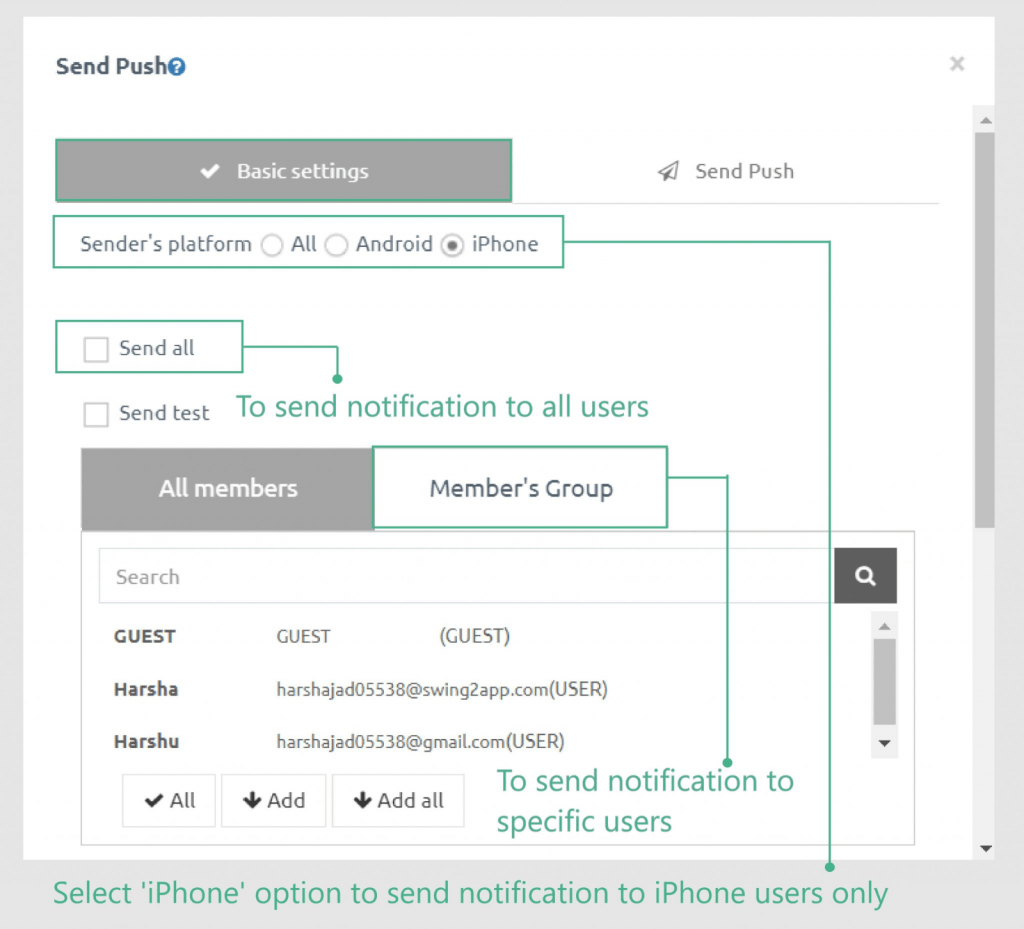
Personalized Notifications:
We make it simple to create personalized notifications that resonate with your audience.
Timing and Frequency Control:
Adjust when and how often your notifications go out with ease.
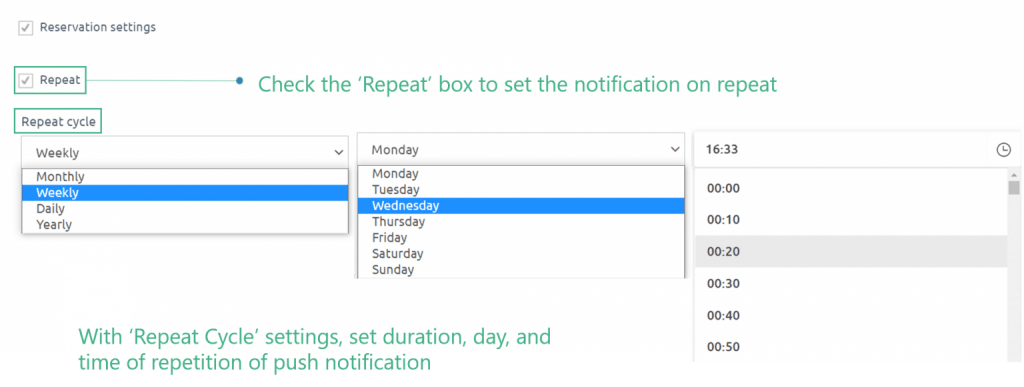
Add Images: Want to make your messages stand out? Swing2App lets you include images effortlessly.
effortlessly.
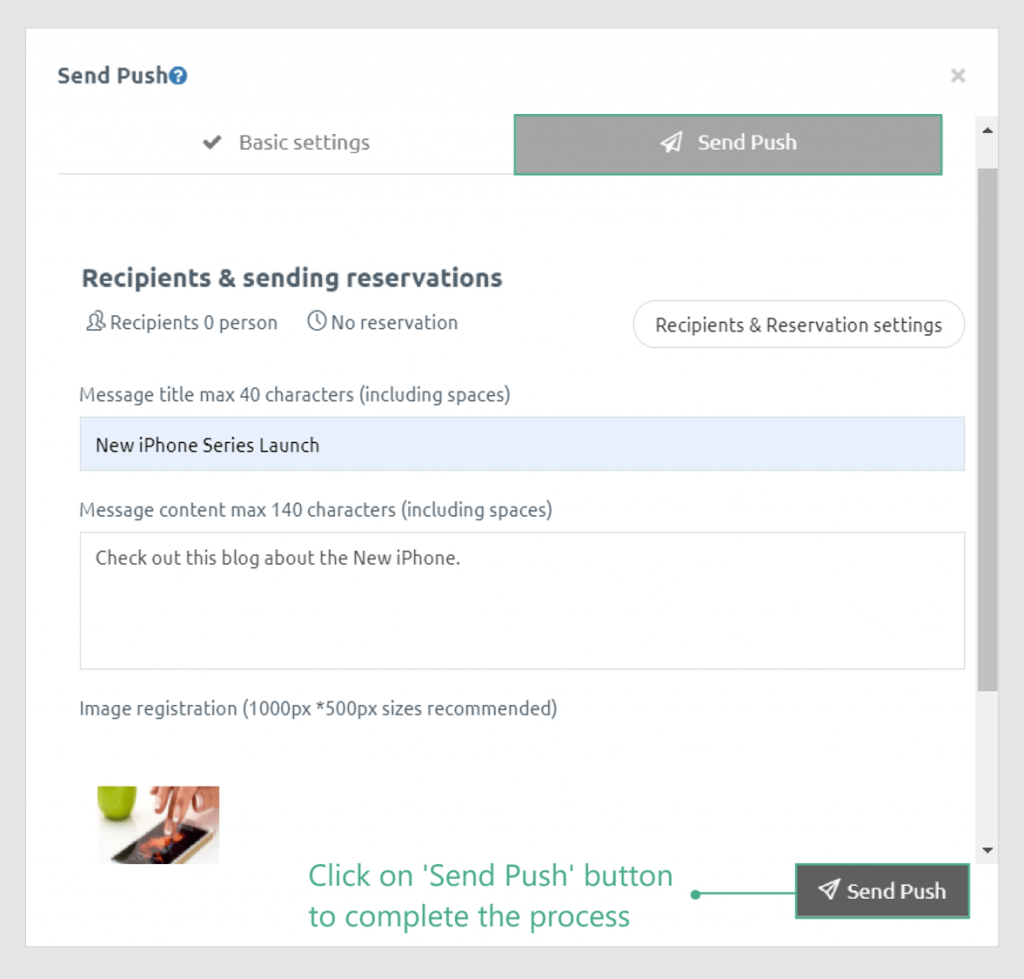
The finalized result will look something like this on the users’ screen:
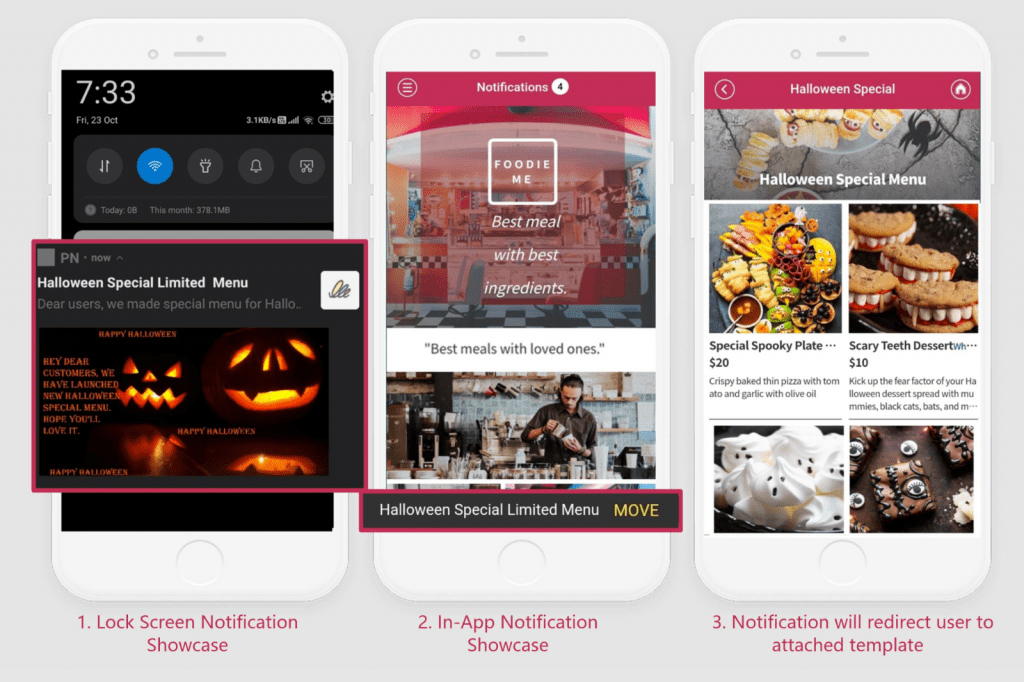
Swing2App’s no-code app builder empowers you to create your app in minutes. And guess what? It comes with awesome features like push notifications, chat, monetization, and more—all for free!
Managing push notifications is a breeze with Swing2App. You can set them up, schedule them, send them, and keep track of everything from one handy dashboard.
So, don’t wait. Build your app now, publish it on Google Play and the Apple App Store, and start wowing your users with push notifications. It’s time to launch killer campaigns and watch your profits soar!
Plus, here’s a bonus: You can also use Swing2App to send SMS messages, available as an optional extra. Say goodbye to limits and hello to effective communication with Swing2App!
Ready to build an App? Use Swing2App!
